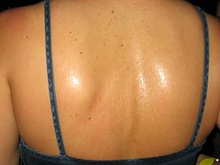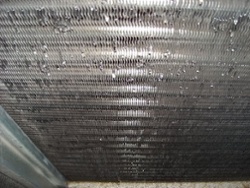It’s Called an Air Conditioner — Not an Air Cooler!

 As I sit here on a nice cool May evening, getting ready for my trip to New England tomorrow, I’m thinking about sweat. And that makes me think about air conditioning. It may seem like it doesn’t make sense, but when you twist your mind around in just the right way, it does. Really! And what I’m thinking about air conditioning is that maybe we just need to stop talking about how many tons of air conditioning a house needs. Because there’s a serious flaw hidden in that kind of talk. Allow me to explain.
As I sit here on a nice cool May evening, getting ready for my trip to New England tomorrow, I’m thinking about sweat. And that makes me think about air conditioning. It may seem like it doesn’t make sense, but when you twist your mind around in just the right way, it does. Really! And what I’m thinking about air conditioning is that maybe we just need to stop talking about how many tons of air conditioning a house needs. Because there’s a serious flaw hidden in that kind of talk. Allow me to explain.
As I sit here on a nice cool May evening, getting ready for my trip to New England tomorrow, I’m thinking about sweat. And that makes me think about air conditioning. It may seem like it doesn’t make sense, but when you twist your mind around in just the right way, it does. Really! And what I’m thinking about air conditioning is that maybe we just need to stop talking about how many tons of air conditioning a house needs. Because there’s a serious flaw hidden in that kind of talk. Allow me to explain.
See that sweaty back above? She’d benefit from some conditioned air, right? Notice that I didn’t say ‘cool’ air. I said ‘conditioned’ air. The difference is important. An air conditioner, you see, does two jobs. It reduces the temperature of the air, and it removes moisture from the air. In my part of the world (the southeastern US), that second job happens to be pretty important. For the woman with the sweaty back, it’s important, too.
Even though we all acknowledge the importance of an air conditioner’s dehumidification capacity, almost no one talks about how much of that capacity their home needs and whether they have the right air conditioner installed to accomplish the job.
First, though, let’s get the HVAC lingo right. We don’t call an air conditioner’s ability to dehumidify its dehumidification capacity. Nope. We call it latent capacity. If you’ve ever had a chemistry course, you may know why. Remember learning about latent heat of fusion and latent heat of vaporization? Those are the energies associated with phase changes, when a substance changes between a solid and liquid or between a liquid and vapor, respectively.

The latent capacity of an air conditioner tells you how much water vapor it can turn into liquid water. It accomplishes that phase change by passing your home’s air over the evaporator coil, which happens to be cold enough that it’s below the dew point of the air. The photo of the coil above shows this process in action. The cold refrigerant passes through copper tubes connected to the closely spaced aluminum fins you see in the photo. The condensation collects on the fins, drips down to the pan, and is removed from the house when it drains away.
The condensation collects on the fins, drips down to the pan, and is removed from the house when it drains away.
Voilà! The sweat from the woman’s back magically evaporates into the home’s comfortably dry air, cooling her in the process. The sweat-turned-water vapor then finds the cold coil and turns to liquid again. The beautiful woman is cool and dry now…as long as her air conditioner was sized properly according to both the sensible and latent loads in the house.
So, let’s get it right. You don’t have a 3 ton air conditioner. You have an air conditioner with a 27,000 Btu/hr (2.25 tons) of sensible capacity (the AC’s ability to lower the air temperature) and 9,000 Btu/hr (0.75 ton) of latent capacity. The air conditioner does two jobs, and there are two numbers to describe how well your air conditioner handles them.
Related Articles
The Magic of Cold, Part 1 – How Your Air Conditioner Works
Dew Point — A More Meaningful Measure of Humidity?
Learn the Lingo – Air Conditioning Terminology & Tidbits
Photo at top by kencf0618 from flickr.com, used under a Creative Commons license. Photo at bottom by Katie Tegtmeyer from flickr.com, used under a Creative Commons license.
This Post Has 9 Comments
Comments are closed.

You explain the latent heat
You explain the latent heat very clearly and, in the HVAC lingo, what sensible heat is – the heat removed to lower the air’s temperature. But maybe I am still not seeing the difference clearly enough.
Is it right to say that you have to take away the sensible heat before you can start taking away the the latent heat? That is, the air has to be cooled to the dew point by removing the sensible heat before condensation will occur at the coil by removal of latent heat.
Or am I off track somehow.
Paul
Right on!! This is why I have
Right on!! This is why I have a very simple dehumidification control on my AC. It’s a simple humidistat (eBay $15) and a SPDT relay ($8) set up to change the blower speed depending on interior humidity. When higher than humidity setpoint blower is on “low”, when humidity drops the humidistat puts the blower relay on high speed. Very simple to wire up on a standard PSC blower, anybody with HVAC knowledge in a humid climate should have their system set up this way.
Variable speed systems are even easier, most have a “dehumid” terminal you can hook straight to the humidistat.
Hi Allison,
Hi Allison,
We need to be careful as the Sensible Heat Ratio is affected by over sizing coils to achieve higher SEER’s. Also, for moisture to be removed the unit needs to run. As you have pointed out, Manual J will
oversize an AC system at least 99% of the time, but worse, the selected unit will be more than 33% oversized , more than 80% of the time causing moisture related problems, not to mention that IAQ devices only work when the system operates. Two stage and Fully modulating units remove moisture at ten time the rate of on/off units.
The question becomes one of part load conditions. Why, with all the sophisticated load calculation procedures like ASHRAE, RTS, and Operating Load Calculations available to us that give insight into the time variant loads a home experiences, would Building Scientists advocate by far the most primitive method that describes the world less than 1% of the time?
The best HVAC designers I know, focus on moisture removal and not Cooling. It’s silly to make a big fuss about sizing and then install A single stage AC that is always oversized.
Great Topic,
pj
People are perverse, they
People are perverse, they resist the product you want to deliver, they just think “cold”. As far back as when Carrier was pioneering AC in theaters, they promoted dry air at a moderate temperature. But theater managers chronically ignored that and cranked up the machinery to overcool instead. There is a fascinating book titled “Air Conditioning America: Engineers and the Controlled Environment, 1900-1960” which describes this.
What you sell to people apparently must be reduced to very simple and very elementary. Thermometers are ubiquitous and accurate, humidity meters are rare and rarely accurate.
Your message is right of course, but getting acceptance will be difficult.
pj must live in a moist
pj must live in a moist climate. In the West (except parts of the Pacific Northwest) the best HVAC contractors focus on sensible cooling not latent cooling.
With respect to wet climates, not only should you slow the fan down, but also STOP it immediately after the compressor shuts down. If you don’t do that you will evaporate the water off the coil and put it back into the house. The Fieldpiece LER5C120 motor does that.
The same motor also runs at a higher speed when the air in the house is already dry enough and runs the fan a variable length of time after to provide additional sensible cooling.
Be careful assuming that an air conditioner will provide the latent capacity listed in the manufacturers’ literature. Those numbers are only good for Steady State (not cycling).
Simply stated, we need two different types of machines for two different climates. Dry machines for the Western region and Wet machines for the Eastern region. The common AC rated by SEER dies neither very well. There was an opportunity to obtain different ratings for dry and wet regions, but under pressure from the manufacturers, the efficiency advocate organizations caved.
I note two items in my
I note two items in my previous post. The last paragraph that says SEER dies, should say DEER does.
In addition I was not clear — the LER motor shuts off the fan at the end of the compressor cycle in wet climates to increase latent capacity. And yes before anyone asks, we do have a connection to that motor development.
Paul wrote:
Paul wrote:
> Is it right to say that you have to take away the sensible heat before you can start taking away the the latent heat?
Not exactly. During the initial minutes of a cycle, the evap coil is not yet cold enough to condense moisture. During this period, only sensible cooling occurs. That’s not the same as saying that the sensible heat must be removed first. Once condensation begins, the system is removing both sensible and latent heat.
As Allison pointed out, latent heat is related to the phase change from vapor to liquid. What actually happens is a tiny amount of heat is released by each drop of water as it condenses on the coil. This heat must be removed along with heat from the space being conditioned.
@John, good point to ensure fan shuts off with compressor in humid climates. Many people may be unaware that their thermostat or air handler has a delay (harvesting) feature. As I’m sure you know, HVAC manufacturers used this strategy to help meet the new 13 SEER requirement. In the AHRI database, a rating that depends on this is indicated by +TDR in the Indoor Unit Model field.
In dry climates (or even in humid climates during periods when moisture levels are low), efficiency can be improved by running the fan post-cycle. This temporarily turns the AC into an evaporative cooling system. My t’stat supports a delay of up to 128 seconds. In monsoon season, the coil stays wet for longer than that, and I’m running about 480 cfm/ton. Cheap cooling.
Too bad about the DOE’s regional SEER program (as mandated by Congress in 2007 EPact I recall you conducted seminal research for the CEC? on hot-dry designs and efficiency impacts. Have read some of papers, I got involved in an ad-hoc group advising DOE rulemaking. You’re exactly right… a well known efficiency advocacy group caved. What we ended up with is regional SEER standards (different minimum SEER for different markets beginning in 2016), rather than asking manufacturers to tell the truth. Sigh.
Sorry, that last paragraph
Sorry, that last paragraph was botched. Again, with feeling…
Too bad about the DOE regional SEER program (as mandated by Congress in 2007 EPAct). I recall you conducted seminal research for the CEC on hot-dry designs and efficiency impacts. Having read some of your papers, I got involved in an ad-hoc group advising DOE rulemaking.
You’re exactly right… a well known efficiency advocacy group caved. What we ended up with is regional SEER standards (different minimum SEER’s for different markets beginning in 2016), rather than asking manufacturers to tell the truth. Sigh.
David, the humidistat trick
David, the humidistat trick will also shut down the time delay if you use it to break the “Y” connection to the board. On “dehumidify” the “G” connection is active on the board, reducing fan speed and cancelling the built in delay. When Humidity drops the humidistat connects the “Y” terminal and engages high speed blower plus activates the built in time delay on the furnace board. Works well for a $15 investment.